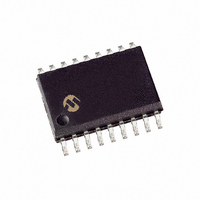PIC16CE625-04I/SO Microchip Technology, PIC16CE625-04I/SO Datasheet - Page 32

PIC16CE625-04I/SO
Manufacturer Part Number
PIC16CE625-04I/SO
Description
IC MCU OTP 2KX14 EE COMP 18SOIC
Manufacturer
Microchip Technology
Series
PIC® 16Cr
Datasheet
1.PIC16CE623-04P.pdf
(113 pages)
Specifications of PIC16CE625-04I/SO
Core Processor
PIC
Core Size
8-Bit
Speed
4MHz
Peripherals
Brown-out Detect/Reset, POR, WDT
Number Of I /o
13
Program Memory Size
3.5KB (2K x 14)
Program Memory Type
OTP
Eeprom Size
128 x 8
Ram Size
128 x 8
Voltage - Supply (vcc/vdd)
3 V ~ 5.5 V
Oscillator Type
External
Operating Temperature
-40°C ~ 85°C
Package / Case
18-SOIC (7.5mm Width)
For Use With
XLT18SO-1 - SOCKET TRANSITION 18SOIC 300MIL309-1075 - ADAPTER 18-SOIC TO 18-SOICAC164010 - MODULE SKT PROMATEII DIP/SOIC
Lead Free Status / RoHS Status
Lead free / RoHS Compliant
Data Converters
-
Connectivity
-
Available stocks
Company
Part Number
Manufacturer
Quantity
Price
Company:
Part Number:
PIC16CE625-04I/SO
Manufacturer:
MICROCHI
Quantity:
11
PIC16CE62X
6.3
6.3.1
Following the start signal from the processor, the
device code (4 bits), the don’t care bits (3 bits), and the
R/W bit, which is a logic low, is placed onto the bus by
the processor. This indicates to the EEPROM that a
byte with a word address will follow after it has gener-
ated an acknowledge bit during the ninth clock cycle.
Therefore, the next byte transmitted by the processor is
the word address and will be written into the address
pointer of the EEPROM.
acknowledge signal from the EEPROM, the processor
will transmit the data word to be written into the
addressed memory location. The EEPROM acknowl-
edges again and the processor generates a stop con-
dition. This initiates the internal write cycle, and during
this time, the EEPROM will not generate acknowledge
signals (Figure 6-5).
6.3.2
The write control byte, word address and the first data
byte are transmitted to the EEPROM in the same way
as in a byte write. But instead of generating a stop con-
dition, the processor transmits up to eight data bytes to
the EEPROM, which are temporarily stored in the on-
chip page buffer and will be written into the memory
after the processor has transmitted a stop condition.
After the receipt of each word, the three lower order
address pointer bits are internally incremented by one.
The higher order five bits of the word address remains
constant. If the processor should transmit more than
eight words prior to generating the stop condition, the
address counter will roll over and the previously
received data will be overwritten. As with the byte write
operation, once the stop condition is received, an inter-
nal write cycle will begin (Figure 6-6).
FIGURE 6-5:
DS40182C-page 32
SDA LINE
BUS ACTIVITY
PROCESSOR
BUS ACTIVITY
X = Don’t Care Bit
Write Operations
BYTE WRITE
PAGE WRITE
S
T
A
R
T
S
BYTE WRITE
1
0
1
CONTROL
BYTE
After receiving another
0
X
X
X
0
A
C
K
X
ADDRESS
WORD
6.4
Since the EEPROM will not acknowledge during a write
cycle, this can be used to determine when the cycle is
complete (this feature can be used to maximize bus
throughput). Once the stop condition for a write com-
mand has been issued from the processor, the
EEPROM initiates the internally timed write cycle. ACK
polling can be initiated immediately. This involves the
processor sending a start condition followed by the
control byte for a write command (R/W = 0). If the
device is still busy with the write cycle, then no ACK will
be returned. If no ACK is returned, then the start bit and
control byte must be re-sent. If the cycle is complete,
then the device will return the ACK and the processor
can then proceed with the next read or write command.
See Figure 6-4 for flow diagram.
FIGURE 6-4:
Acknowledge Polling
A
C
K
Initiate Write Cycle
Send Control Byte
ACKNOWLEDGE POLLING
FLOW
Write Command
with R/W = 0
Did EEPROM
Condition to
Acknowledge
Send Stop
(ACK = 0)?
Send Start
Operation
Send
Next
DATA
1999 Microchip Technology Inc.
YES
NO
A
C
K
P
S
T
O
P















